Oberschöneweide
Oberschöneweide (Upper Schöneweide) is a German locality (Ortsteil) within the Berlin borough (Bezirk) of Treptow-Köpenick. It is, with Niederschöneweide (Lower Schöneweide), part of the geographic area of Schöneweide. Until 2001 it was part of the former borough of Köpenick.
Oberschöneweide | |
|---|---|
Quarter of Berlin | |
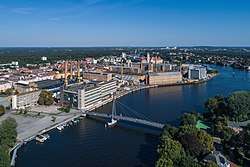 Industrial buildings over the Spree river | |
 Coat of arms | |
Location of Oberschöneweide in Treptow-Köpenick and Berlin 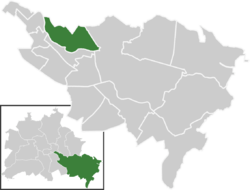 | |
 Oberschöneweide 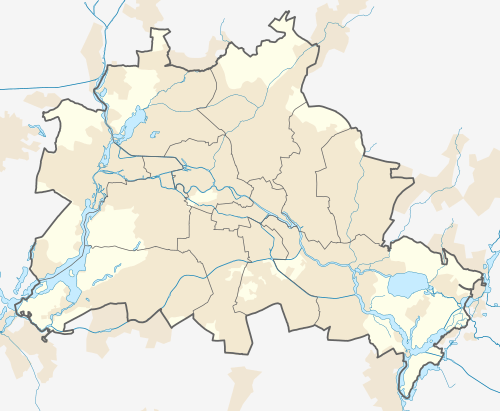 Oberschöneweide | |
| Coordinates: 52°27′43″N 13°30′54″E | |
| Country | Germany |
| State | Berlin |
| City | Berlin |
| Borough | Treptow-Köpenick |
| Founded | 1598 |
| Area | |
| • Total | 6.18 km2 (2.39 sq mi) |
| Elevation | 34 m (112 ft) |
| Population (2008-06-30) | |
| • Total | 17,094 |
| • Density | 2,800/km2 (7,200/sq mi) |
| Time zone | CET/CEST (UTC+1/+2) |
| Postal codes | (nr. 0909) 12459 |
| Vehicle registration | B |
History
First mentioned in 1598 as Schöne Weyde, it became an industrial town at the end of the 19th century. In 1920 it merged into Berlin with the "Greater Berlin Act".
The Berlin territorial reform with effect from 1 April 1938 also affected the districts Treptow and Köpenick. The districts Oberschöneweide and Wuhlheide were removed from the district Treptow and incorporated into the district Köpenick.
In the Nazi era Oberschöneweide developed into a stronghold of resistance against National Socialism, which despite constant arrests and death sentences could not be broken. The resistance cells were the most numerous in the years 1942-1944. The factories in Oberschoeneweide remained the foundation of the illegal Berlin KPD headquarters.
The mass recalls from 1941 resulted in a lack of staff in the factories. In order to maintain production, more and more forced laborers from all over Europe were employed. Several barracks camps were built for forced laborers in Wuhlheide. Here was also the same named, the Gestapo subordinate Berlin work education camp. More than 6,000 foreign forced laborers worked in Kabelwerk Oberspree and other factories located in the AEG factory complex, as well as female inmates of the Sachsenhausen concentration camp in 1944/1945.
In the air raids of the Allies on June 21 and August 6, 1944, Oberschöneweide was covered with a dense bomb carpet, while the Kabelwerk Wilhelminenhof heavily destroyed. The attack of February 26, 1945 met Oberschöneweide once again in its entirety. Among the casualties were many foreign forced laborers.
On April 16, 1945, during the Battle of Berlin (one of the last battles of World War II in Europe), before the German troops left Oberschöneweide, they tried to stop Red Army at the bridges "Kaisersteg" and "Treskowbrücke". On April 24 the zone was in the hands of the 8th Guards Army of the Soviet Union.
The administrative division of Greater Berlin by the Allied victorious powers Oberschöneweide fell with the other districts of the district of Köpenick under Soviet control.
As everywhere else in the Soviet occupation zone, all non-destroyed means of production were dismantled and brought to the Soviet Union in Oberschöneweide. It followed the expropriation of the industrial enterprises; they were later converted into state-owned enterprises.
The Queen Elisabeth Hospital served Soviet troops as a military hospital from October 1945 and remained there until the complete withdrawal of Soviet / Russian troops from Germany in 1994.
In the 1950s, the radio house Nalepastraße was built. Here, all the radio programs of the GDR were produced centrally by the radio of the GDR.[1]
Due to the changing economy since the reunification on 3 October 1990, many companies have suffered layoffs, closures and privatisations. This was the end of the traditional industrial location. The South Korean industrial giant Samsung operated on the Samsung SDI in Oberschöneweide until the end of 2005, a production site for tube TVs and mobile devices. He gave up the location despite the receipt of subsidies in the millions of subsidies by the state of Berlin due to sales problems and inefficiency. The industrial buildings Oberschöneweides are listed since 1991 and are a focal point of the Berlin industrial heritage. Many small craft enterprises have settled on the industrial estates. The traditional medium-sized companies include Silicon Sensor GmbH (formed by the spin-off of the former television electronics factory) and BAE Batterien GmbH (at the location of Accumulatoren Fabrik Aktiengesellschaft, AFA). In 2006, the former AEG terrain was redeveloped into the HTW Berlin, Hochschule für Technik und Wirtschaft Berlin. As of 2017, there are 18,000 students.
During rush hours, several roads were congested at many times which is at Spree-, Edison- and Siemensstraße. As a result, the surrounding residential areas are affected, which led to the inclusion of the entire area in the noise reduction planning in Berlin. To relieve the congestion, two more bridges are planned. The Minna Todenhagen Bridge is part of the southeastern connection, to be completed in the first phase. It leads east to the Britzer canal over the Spree and connects the Rummelsberg Road, over the Minna Todenhagen Road with the Köpenicker country road and fast road on Niederschöneweider area. On February 27, 2012, the plan approval decision was issued, construction began in 2013. The construction period should be three years. On 21 December 2017, the road was opened to traffic. The other bridge, Wilhelminenhofbrücke, whose construction project is still in planning, is to lead to the eastern extension of Wilheminenhofstraße over the Spree to the Schnellerstraße in the Oberspree.
Geography
Located in the south-eastern side of the city and crossed by the river Spree, Oberschöneweide borders with the localities of Plänterwald, Baumschulenweg, Niederschöneweide, Köpenick, Karlshorst and Rummelsburg (both in Lichtenberg district). Its urban park is the Wuhlheide, in which is located the ridable miniature railway Berliner Parkeisenbahn (BPE), used during the East German period by the Young Pioneer Organisation.
Education
The Hochschule für Technik und Wirtschaft (HTW - translated as University of Applied Sciences for Engineering and Economy), the youngest and largest University of Applied Sciences of Berlin, has the Campus Wilhelminenhof [2] located in Oberschöneweide. In addition, the German Ministry of Education in this town has 3 urban day care centres, ten schools - two primary schools, one integrated secondary school (integrated programme) and seven other secondary schools (no other high school).
Other institutions, which is similar to the SkillsFuture for their training institutions, and also parts of the institute of adult learning. Many of the students are attached to various companies in the area which is for the internship (industrial attachment programme):
- Technologie- und Gründerzentrum Spreeknie (TGS)
- E. Michaelis & Co. KG; Papiergroßhandlung
- First Sensor AG, vormals Silicon Sensor GmbH; Hersteller von optischen Sensoren
- BAE Batterien GmbH
- iris-GmbH – Hersteller des automatischen Fahrgastzählsystems IRMA
- Berliner WasserSportZentrale GbR; Sportbootschule
- Sportstudio Orange-Fit (Golightly Energy GmbH)
Transport
The locality is served, as urban rail, by the S-Bahn line S3, at Wuhlheide station, partly located in Köpenick. Located by the southern shore of the Spree in Niederschöneweide, it is the station of Schöneweide. The locality is also served by the tramway lines M17, 21, 27, 37, 63 and 67. At Wilhelmstrand, by the river, it is a short ferry service (line F11) that links it to Baumschulenstraße, in Baumschulenweg.
The northern part is located from Rummelsberg, Lichtenberg and on the other hand from the district Karlshorst on the street Am Walde, on the Rummelsburger highway along the Treskowallee and Rudolf-Rühl-Allee, which runs along the eastern edge of town and meets the street An der Wuhlheide.
There were plans for the U5 to be extended from Friedrichsfelde via Karlshorst, to Oberschöneweide in the 1950s, however this was not realized with the extension to Hönow in the late 1980s. Since 2017, the bus service 365 was introduced from Oberschöneweide to Baumschulenweg.
Photogallery
- The centrum of the quarter
 The old Kaisersteg in 1900
The old Kaisersteg in 1900- A BPE train in Wuhlheide
- Wilhelmstrand ferry station
- The Christ church
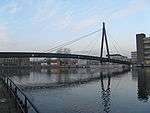 The new Kaisersteg
The new Kaisersteg- The new Treskowbrücke
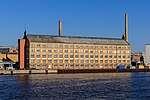 A factory on the Spree
A factory on the Spree
Personalities
- Emil Rathenau (1838–1915)
- Walther Rathenau (1867–1922)
References
- (in German) Historical infos about Oberschöneweide
- (in German) Infos about the Campus Wilhelminenhof on HTW website
Literature
- Judith Uhlig: "Köpenick – Geschichte der Berliner Verwaltungsbezirke". Stapp Verlag 1997, ISBN 3-87776-077-5
- Hans-Jürgen Rach: "Die Dörfer in Berlin". VEB Verlag für Bauwesen, Berlin 1988 ISBN 3-87776-211-5
External links
![]()
- (in German) Oberschöneweide page on www.berlin.de